
They've gone and done it again.
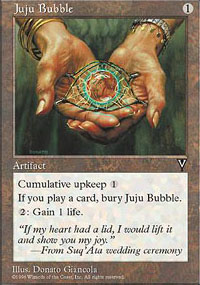
Apparently so powerful it needed
two drawbacks. Good call folks.
Rather than stoke the embers of the debate about Wizards hosing combos for some reason or another, I want to walk you through the annals of Magic history to locate other times this sort of thing has happened. The fortunes of a card can be tied to a few different factors even once it is printed and sold. This change in Oracle text is just the latest visible one. It's actually quite a common occurrence for a card to become significantly less or more useful over time. And not all are the result of sudden changes. And, well...you'll see what I mean.
You should know that not all cards in this game are created equal. Some are clearly very powerful (Duress comes to mind) and have always fit nicely into many decks. Others, like Aven Shrine, well, not so much. Although someday I will perfect the Juju Bubble sleaze that rocks you all! That part is easy to see (not the Juju Bubble sleaze, stop thinking about that - it's mine to discover). I'm not here to discuss the hidden gems in sets. There are plenty of writers discussing that.
So What Shall We Talk About?
This article intends to examine some of the most extreme examples of the playability of particular cards fluctuating over the game's history as well as some insight into what this has meant for the environments in which it occurred. Let's get started, shall we?
This here is Andrew Hayes' first place Regionals deck. Most folks are already familiar with the concept (or can surmise it quickly enough), so I will cut to the chase. One of the chief reasons this deck works is that Promise of Bunrei is so effective at creating tokens. And that's more to sacrifice to the Husk, or Ghost Council. In fact, Promise of Bunrei is a powerful-as-hell card to begin with. So why was it nearly unused in Standard for about a year after its printing? What happened to make this card so important?
Why, Orzhov happened, of course. When you take a powerful card in a vacuum, you get Drop of Honey or Fangren Firstborn. These types are super as an amusing casual deck centerpiece. But when you add in requisite helper cards such as Plagued Rusalka, Nantuko Husk, and Ghost Council of Orzhova you get a powerhouse. And rightly so. MaRo made a point to mention that cards from different blocks should work together more efficiently under his watch, and indeed they have. Very cool.
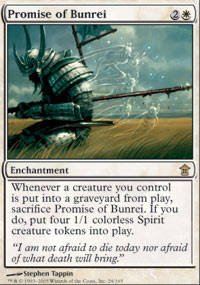
If you can manage the trigger
consistently, four pecks is a dandy
of a deal at .
Bazaar of Baghdad is another. Until Odyssey Block made the graveyard a storehouse for lovelies (to say nothing of the madness mechanic), this card was relegated to cute tricks. Most new players would scoff at the idea that the Bazaar was ever a paltry effect. But the graveyard was not always so important. Discarded cards used to be essentially dead (hence the name "graveyard"). Bazaar was always insane, just unusable at the same time. Go figure. Use it alongside the Welder today, however, and you have some of the sleaziest interaction this side of Yawgmoth's Will. On second thought, perhaps some watery tart did throw a sword at this busted bunch.
I should mention that Ichorid is noticeably not in this category of cards. One could argue that it is not a particularly powerful card - just the right one for the job. I don't agree with that assessment because I believe that its uses will continue to grow over time, albeit slowly. But the fact that it is a niche card like Sutured Ghoul and not generally useful like Lightning Helix could be grounds for an argument to the contrary.
Fine, So Cards Get Stronger Over Time.
Not always. Years ago Berserk was just nuts - so much though, that it landed on the first Limited List, what we now call the Restricted List. As there were no “types” back then, it applied to all tournaments. It remained there in Vintage until 2003. Wizards took the hint that creatures in Vintage didn't attack any more, and if they did, no one was willing to trade the controlling position of having a creature in play for the benefit of dealing double damage one time. So off it came.
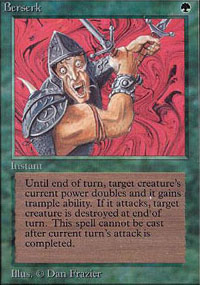
Psychatog decks called "Hulk" had
been using one Berserk as a
Cunning Wish target at the
time of its unrestriction in Vintage.
After its unrestriction they
still used only one. Looks like
it is not as abusive in multiples
as it once was.
And why not? Hypnotic Specter, long considered too good to reprint was rightfully unveiled for 9th. And for some reason it did not turn Standard into the "Specter Format". We all know why that is - Dark Ritual is gone. Its environment dictated its power as much as the words on the cardboard. Wizards has been fooling with the double mechanic more and more these days, as cards like Doubling Cube, Wine of Blood and Iron, and Feral Animist demonstrate. We may be seeing more of Berserk someday.
Maze of Ith is another card with a tarnished reputation. When The Dark premiered back in 1994, this card was restricted immediately. They were common, so we all had dozens of them just taking up space in our collections, but we knew how powerful a card it was. Maze of Ith was an obvious entry into any deck no matter what. Remember that creature combat with multiple creatures attacking and blocking was more common back then. So, Maze of Ith was actually an effective tool on offense. It allowed you to undo any block the opponent made - the one that hurt you most. Not to mention the obvious defensive monster it was. Wrath of God was in full glory even back then, and control decks could simply Maze an attacker until they drew it, netting a one card advantage in the transaction since the opponent would have to attack with at least two creatures for even one to get through. It was a most annoying strategy that always worked. You may be thinking that Strip Mine was around back then, and it was. But it wasn't until its reprinting in Fourth Edition that it managed to get itself restricted. Why is that when it was nuts as well? Few people had been using it. That's why. It was a very cloudy time.
OK, So What Happened to it?
Well, bluntly, Wasteland happened. Certain elements of creature combat (like blocking) have been in general decline in the eternal formats since long before they were called eternal, but it was the printing of Wasteland that greatly accelerated what was a similar slow decline for Maze of Ith. Wasteland is a perfect hoser for Maze and produces mana as well, making it far more popular. With so many opposing decks packing Wasteland, the Maze stands little chance of saving your life. Also, with so many effective ways to access hosers via more and more tutor effects, many players can just bounce the Maze before attacking. So it just takes up an otherwise productive land drop.
To be honest, Wasteland has undergone a gradual increase in power as the years have gone on. With more lands to choose from, a mana base has not simply been "23 Islands and you're done" for many years. Every set makes Wasteland slightly more powerful. I daresay that Extended would not have had nearly the diversity in color combinations this past year if Tempest were still legal just because of this card.
While the rotation of cards out of a cardpool can have a dramatic effect on a format, so (naturally) can the inclusion of a card. Land Tax, for example, was a cool card in Legends, but format-altering in 4th Edition. Why? Well, to begin with, Legends was never part of Standard. There was never a Legends without broken acceleration except for old Legacy. So Land Tax was largely marginalized by quality non-land mana sources. But it was also not in a format as closely studied as Standard tends to be. Perhaps that is why Wizards decided to reprint it in the first place. But it became the archrival of broken draw, and noted as clearly broken itself. What does this teach us? Don't label the Dark Depths of the world as scrap paper just yet. The counter-removing block may be just around the corner.
But Wait. There's More.
So a shift in metagame and cardpool can cause cards to fluctuate in power. But there are other causes behind power shift as well. Do you remember a card called Avoid Fate? I remember looking at that card and its big brother, Ring of Immortals and wondering how I could possibly ever use them. Notice how it says "Interrupt" in the text. Well, at the time, there wasn't much more you could hope to prevent than Control Magic or Paralyze. The cards were underwhelming to say the least. But then 6th Edition rules changed all that. All interrupts became instants, and the cards went from entirely unplayable to merely narrow. So while Ring of Immortals is still just a silly overcosted artifact, at least Avoid Fate does something. And it could occasionally be the right card for the job due to its reasonable cost and rare ability in Green.
Other cards have been affected in a less pleasant way by these rules changes. Master of Arms was a decent card back when Weatherlight was in print. Under pre-6th Edition rules, tapped creatures did not deal combat damage when blocking, hence the ability on this card. These sorts of changes make cards like Boa Constrictor feasible. But now the activated abiity on Master of Arms is quite laughable. On the other side of that coin anything with a potential combat trick that has the tap symbol in the activation got a significant boost. Tim and friends found themselves invigorated by the change. That whole "after damage is on the stack" phrase didn't even exist before. Considering the benefits, I am glad that Master of Arms was gutted on the altar of change (in some farcical aquatic ceremony - OK, I'll stop).
Waylay is an interesting example of a card that was made so good under these new rules that it had to receive errata. If you aren't familiar with this scenario, take a moment to read the card text (not the Oracle text) and try to sleaze it. It's OK. I can wait...
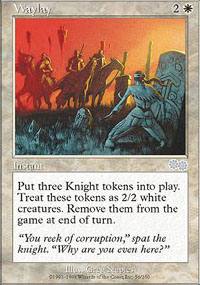
Known as "White Lightning" for its
similarity to that red spell that
deals six damage for .
And?
And that brings us back to the recent change in errata on some older cards.
I want to take a moment to discuss Sorrow's Path. That's what I'm all on about. I have actually seen that card in play a few times, but never used. A few years ago, a friend of mine set out to make use of this card. The person playing it was not afraid of killing his own creatures. He had Chaoslaced it and his critters all had Protection from Red. No, he just never, ever saw the amazingly rare situation occur where there were enough legal targets to actually tap it. In the distant past, you could at least Gauntlets of Chaos the card to the opponent and tap it manually with Icy Manipulator. This created a pretty fair effect. But the text has been errated by Wizards to prevent that. Why? Is this for power level concerns? I thought that was what this latest round of rules rewrites was supposed to correct. And as it is now it just sits in play, having no gainful effect at all, ever. I'm only half serious about this, but since City of Brass has been reprinted many times with its original text intact, why must Sorrow's Path remain changed?
Time Vault has seen a lot of errata in its existence. The recent changes caused the kind of up-and-down rollercoaster of power fluctuations that made the secondary marketeers scratch their heads. But it did not start there. Time Vault has always been a difficult card to maintain, and the wording changes designed to keep the card doing the rather narrow duty it was designed for have been considerable.
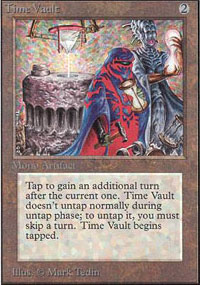
"Time counters" (removed at
activation and only added when you
pay the untap cost) successfully
kept this card sleaze-proof for more
than a decade.
But then, at about the same time as the release of Ravnica, newly apppointed Rules Manager Mark Gottlieb decided to clean out the wordings on some older cards. At this same time, many Legacy and Vintage players were trying to find the optimal use for old Time Vault and a new Fireball variant called Flame Fusillade which got around the time counters by winning on the spot just by untapping it many times. Interest in Time Vault became sky high, and this long-time silly card had become hard to find. When Wizards announced that Time Vault had been reworded again, a frenzy of attention was paid to why the company would go out of its way to hose a combo before it even made a dent in the metagame. But the fact is that cards change in power. It happens. So with the combo nerfed, the usefulness of Time Vault again plummeted. But we are not done yet. Because as part of a broader effort, Wizards just again changed the Oracle text on Time Vault to its current form. As luck would have it, Mizzium Transreliquat makes a dandy copy of Time Vault without the nasty side effect. And so a new combo is born, and we get to see this card make us cringe once again as players pervert it into whole new a cycle of endless turns.
Could this combo make a splash in one of the eternal formats? It seems likely that a two-card infinite combo with no color requirements at all would. But, don't you know, no one has got it down just yet. As usual, Legacy seems the likely home of this handsome new sleaze, and it is just waiting to be found. And that is Legacy in a nutshell. Lots of potential. Too few people to bring it all to the light.

Comments